At the time of this hike the map holder at the Hither Hills West Overlook was stocked with black and white maps but other map holders along the way were empty so best not to count on getting a map upon arrival. The East Hampton Trail Guide, a waterproof, tear proof, full color map can be ordered from the East Hampton Trails Preservation Society in advance. ...
Hike Description:
At the time of this hike the map holder at the Hither Hills West Overlook was stocked with black and white maps but other map holders along the way were empty so best not to count on getting a map upon arrival. The East Hampton Trail Guide, a waterproof, tear proof, full color map can be ordered from the East Hampton Trails Preservation Society in advance. Click here for map ordering information.
Where a scenic overlook is considered the payoff for your hiking efforts, this hike starts off with advance payment right at the Hither Hills West Overlook parking lot. Take in the 180-degree views that include the Atlantic Ocean on the other side of the highway before you begin your hike.
Although many of the trails are blazed with color-coded diamond markers, the corresponding colors are not shown on either of the maps. Signs at intersections do let you know the name of the trail to reference to the map.
With your back to the highway turn left and proceed to the “Petticoat Hill Trail/Elisha’s Valley Trail/Fresh Pond” sign at the corner of the parking lot. This trail, the Petticoat Hill Trail, is marked with brown diamonds and starts out on a wood chip walking surface which will become packed sand and dirt in .15 mile. A few forks along the way merge back together so it doesn’t matter which way you go. Keep to the left following the sign for Elisha’s Valley Loop when the Overlook Bypass Trail leaves to the right.
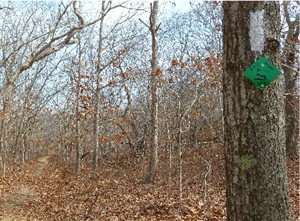 At .4 mile the Petticoat Hill Trail ends at Old North Road and the Hither Hills State Park sign. Turn right on Old North Road for just a few steps then turn left on Elisha’s Trail through Elisha’s Valley. In .35 mile turn right on Old Tar Road for a short distance, then turn left towards the railroad tracks. These are live LIRR tracks so be careful crossing. A short distance after the tracks, arrive at an intersection where you will see white rectangle blazes painted on the trees along the trail straight ahead and also to the right. This is the Paumanok Path, a 125-mile long-distance hiking trail that traverses Long Island. You will be following the white blazes for most of this hike. At times the white blazes will join in with the diamond markers of the park trails where both follow the same path. When there is a turn on the white-blazed trail, it will be indicated by an upside down “L”, the top horizontal line pointing in the direction of the turn. At this intersection, turn right and begin following the white blazes. Although there is no sign, the Stephen Talkhouse Trail, shown on the map, will co-align with the Paumanok Path all the way to Quincetree Landing, 2.8 miles to the east.
At .4 mile the Petticoat Hill Trail ends at Old North Road and the Hither Hills State Park sign. Turn right on Old North Road for just a few steps then turn left on Elisha’s Trail through Elisha’s Valley. In .35 mile turn right on Old Tar Road for a short distance, then turn left towards the railroad tracks. These are live LIRR tracks so be careful crossing. A short distance after the tracks, arrive at an intersection where you will see white rectangle blazes painted on the trees along the trail straight ahead and also to the right. This is the Paumanok Path, a 125-mile long-distance hiking trail that traverses Long Island. You will be following the white blazes for most of this hike. At times the white blazes will join in with the diamond markers of the park trails where both follow the same path. When there is a turn on the white-blazed trail, it will be indicated by an upside down “L”, the top horizontal line pointing in the direction of the turn. At this intersection, turn right and begin following the white blazes. Although there is no sign, the Stephen Talkhouse Trail, shown on the map, will co-align with the Paumanok Path all the way to Quincetree Landing, 2.8 miles to the east.
In half of a mile reach picturesque Fresh Pond. Several side trails to the left bring you directly to the pond for better views over the next 10th of a mile. The white-blazed Paumanok Path then turns right leaving Fresh Pond. In .2 mile, when the white blazes instruct you to turn right, turn left on Fresh Pond Landing Road, marked with purple diamonds, instead. In .1 mile arrive at the Napeague Bay beach. Make note of the Waterfence Overlook Trail on the right – return to this trail if you go all the way to the beach first.
Take the Waterfence Overlook Trail as it climbs fairly steeply for a short distance to the top of a bluff for great views of Napeague Bay. From this viewpoint, turn around, walk through the small parking lot, then along the access road. In just a few steps rejoin white-blazed Paumanok Path by turning left when it crosses over the access road. In .15 mile the Paumanok Path turns left at a T-intersection and starts to parallel the live railroad tracks. Chances are you won’t see a train go by but if you do, it is a different kind of experience seeing a train go right through the woods.
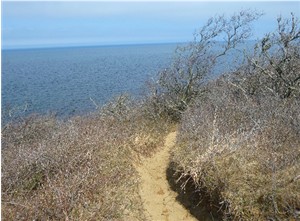 The Paumanok Path veers away from the railroad tracks to the left 2.5 miles into the hike. Shortly after this turn watch for old Indian house ruins on the left. The Paumanok Path now leads along the top of the bluffs where the trail is cut into the packed sand between gnarly, stunted, wind-beaten trees and vegetation. Painted blazed will be rare along this stretch for lack of a surface to paint them on. Some blazes painted on rocks are almost completely covered with sand. Just keep straight on the trail ignoring any side trails, following along the contour of the beach below. You’ll catch many bluff top views of the bay and shoreline over the next half mile.
The Paumanok Path veers away from the railroad tracks to the left 2.5 miles into the hike. Shortly after this turn watch for old Indian house ruins on the left. The Paumanok Path now leads along the top of the bluffs where the trail is cut into the packed sand between gnarly, stunted, wind-beaten trees and vegetation. Painted blazed will be rare along this stretch for lack of a surface to paint them on. Some blazes painted on rocks are almost completely covered with sand. Just keep straight on the trail ignoring any side trails, following along the contour of the beach below. You’ll catch many bluff top views of the bay and shoreline over the next half mile.
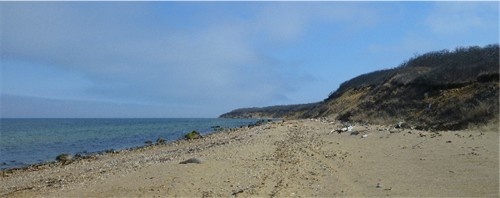 The Paumanok Path temporarily leaves the bluffs 3.5 miles into the hike then turns left joining the green diamond blazed Old North Road, a road once used for smuggling liquor. In just a few steps, a short side trail to the left leads to Quincetree Landing for some views at beach level. In one tenths of a mile, another short side trail to the left leads to bluff top views at The Notch.
The Paumanok Path temporarily leaves the bluffs 3.5 miles into the hike then turns left joining the green diamond blazed Old North Road, a road once used for smuggling liquor. In just a few steps, a short side trail to the left leads to Quincetree Landing for some views at beach level. In one tenths of a mile, another short side trail to the left leads to bluff top views at The Notch.
About .35 mile after The Notch, the white-blazed Paumanok Path leaves Old Notch Road to the left joining up with the Coastal Trail. In another .35 mile, leave the white blazes to the left on an unmarked and unnamed side trail (only shown partially on the map) that heads back to the top of the bluffs, veers right and leads to a flat grassy area, Duck Bluff, 5 miles into the hike. This is a great spot to take a break and enjoy the views over Block Island Sound.
To rejoin the Paumanok Path, with your back to the water, follow the unmarked trail straight ahead for a short distance to a T-intersection with the Paumanok Path; turn left to resume following the white blazes. (Maps do not show this connector trail.)
The Paumanok Path now hugs the top of the bluffs again and bends around to rejoin Old North Road in .7 mile. The combined white rectangle/green diamond path leads to Dyer’s Landing at Rocky Point overlooking Fort Pond Bay. In a quarter of a mile turn right when the white blazes leave Old North Road and join the tan diamonds of Redmond’s Path. In a quarter of a mile, cross over the live LIRR tracks for the second and last time, then cross a sand road a few steps later and veer right at a fork not shown on the map.
In .2 mile turn left on Riah’s Ridge Trail, cross Rod’s Valley Road and ascend to Riah’s Ridge through mountain laurel tunnels. The trail descends the ridge and turns left on Flaggy Hole Road, marked with blue diamonds. In .15 mile turn right on Lost Boulder trail and arrive at the lost boulder in another .15 mile. You can’t miss this huge glacial erratic that borders the trail on the left.
Lost Boulder Trail brings the Paumanok Path back out to the blue-blazed Flaggy Hill Road once more and continues almost to it’s end just before Power Line Road. Watch for the white blazes to leave to the right on a footpath just before this intersection.
In .15 mile cross a woods road and note the huge mound to the right at this intersection. That is the capped Montauk landfill, now a recycling center on the other side of the mound. It’s a sobering sight to see where our garbage ends up – a mark on the landscape forever. Arrive at a woods road that comes in from the left and forks to the right. Cross the over first fork then turn right on the second fork. The Paumanok Path will now circle around the temporarily out-of-sight landfill area over surprisingly hilly terrain and through Laurel Canyon, a 75-foot deep gully.
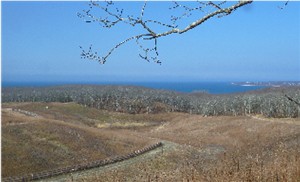 Exiting Laurel Canyon, the Paumanok Path turns right briefly on Upland Road then leaves to the left on a footpath. This path ascends to an overlook above the capped landfill. You can look back at Fort Pond Bay and Block Island Sound, the places you hiked earlier.
Exiting Laurel Canyon, the Paumanok Path turns right briefly on Upland Road then leaves to the left on a footpath. This path ascends to an overlook above the capped landfill. You can look back at Fort Pond Bay and Block Island Sound, the places you hiked earlier.
Continue on the Paumanok Path another .3 mile as the traffic sounds of Route 27 become louder. Just before the highway the white blazes turn left. Leave the Paumanok Path now and turn to the right following the trail parallel to Route 27.
In .2 mile cross the paved recycling center road and continue through the hiker parking lot on the other side to find the beginning of the yellow-blazed Split Rock Road. In .4 mile continue following the yellow markers when Midland Road forks right. At the next intersection, turn left keeping with the yellow markers when the red-blazed Ram Level Loop starts to the right. In another quarter of a mile, arrive at the trail’s namesake, a large split rock on the left side.
When the Split Rock Trail ends, turn right on the gray-blazed Parkway Trail running parallel to Route 27. In .2 mile cross Power Line Road then in a few steps the Serpent’s Back Trail. Arrive back at the parking lot in .1 mile.
Click here for more pictures of this hike.
Turn By Turn Description:
[ 0.00] Park at Hither Hills Overlook with 180 degree views; with back to Route 27 take trail to left where sign points towards Elisha's Valley, Petticoat Hill Trail and Fresh Pond
[ 0.15] Wood chip surface turns to packed sand on Petticoat Hill Trail
[ 0.20] Keep left towards Elisha's Valley Loop when right goes to the Overlook Bypass Trail
[ 0.40] Petticoat Trail ends at Old North Road, turn right on Old North Road for short distance then left on Elisha's Trail through Elisha's Valley
[ 0.75] Turn right on Old Tar Road short distance, turn left and cross live railroad tracks; in a short distance at next intersection turn right on white-blazed Paumanok Path
[ 1.25] Reach Fresh Pond with short side trails to the left for views
[ 1.35] Paumanok Path leaves Fresh Pond to the right
[ 1.55] Turn left on Fresh Pond Landing Road when white goes to the right and follow to Napeague Bay beachfront
[ 1.65] Turn right on Waterfence Overlook Trail just before Napeague Bay beach; overlook and small parking lot at top of hill
[ 1.75] From Waterfence Overlook turn right through the small parking lot and continue on the access road
[ 1.80] Turn left on the white-blazed Paumanok Path when it crosses over the access road
[ 1.95] Paumanok Path turns left at T-intersection and parallels Long Island Railroad tracks
[ 2.45] Keep straight when unmarked trail crosses over
[ 2.50] Trail veers left away from railroad tracks; Indian House ruins on left short distance ahead; white veers right when unmarked comes in from left
[ 2.90] Short side trail to left to view of Napeague Bay
[ 3.50] Paumanok Path turns left on Old North Road following white blazes and green diamonds
[ 3.55] Turn left to Quincetree Landing, beach level overlook; retrace
[ 3.80] Continue left on white/green
[ 3.90] Turn left to the Notch, overlook from a bluff; retrace
[ 4.15] Continue left on white/green
[ 4.50] Paumanok Path leaves woods road to left on footpath (Coastal Trail on map)
[ 4.85] Turn left on unmarked trail when white continues straight
[ 5.00] Grassy overlook on left at Duck Bluff; turn right in unmarked trail (not on map) briefly to rejoin white-blazed Paumanok Path; turn left on Paumanok Path
[ 5.35] Veer left at fork, right goes to picnic area
[ 5.70] Paumanok Path rejoins green-blazed Old North Road
[ 5.85] Short side trail to left to Dyer's Landing; retrace
[ 5.90] Continue left on white/green
[ 5.95] Paumanok Path turns right on tan-blazed Redmond’s Path through Jack Cord's Valley (to visit the pier in Rod’s Valley, keep straight to the pier then retrace for .65 mile total out and back)
[ 6.20] Cross live LIRR tracks, cross over sand road, then at fork keep right
[ 6.40] Paumanok Path turns Riah's Ridge Trail, climbs over ridge and descends
[ 6.65] Cross Rod's Valley Road and ascend to Riah's Ridge
[ 6.75] Keep right at unmarked fork (not on map), blazes start up again short distance ahead
[ 7.05] Paumanok Path turns left on Flaggy Hole Road, now following white rectangle and blue diamond
[ 7.20] Paumanok Path leaves Flaggy Hole Road to right on Lost Boulder Trail
[ 7.35] Lost Boulder
[ 7.55] Paumanok Path turns right on Flaggy Hole Road
[ 7.65] Paumanok Path turns right on foot path just before Flaggy Hole Road ends at Powerline Road
[ 7.75] Keep right at unmarked fork, blazes start up again short distance ahead
[ 7.80] Cross woods road with capped landfill visible to the right
[ 7.85] Cross first fork of woods road that comes in from the left, turn right on second fork
[ 8.00] Cross sand road then keep right entering Laurel Canyon
[ 8.15] At bottom of switchback, keep right when trail not on map comes in from left
[ 8.25] Seasonal views of Fort Pond Bay at top of incline then trail switchbacks down into Laurel Canyon
[ 8.55] Trail turns sharply left - marked but easy to miss if not paying attention because a trail continues straight also
[ 8.70] Paumanok Path turns right on Upland Road briefly then leaves to the left
[ 8.90] Overlook above the capped landfill with views of Fort Pond Bay
[ 9.15] Keep left at unmarked fork
[ 9.20] Turn right on Parkway Trail leaving the Paumanok Path when Paumanok Path continues to the left
[ 9.40] Cross recycling center road and continue through small hiker parking lot on yellow-blazed Split Rock Road
[ 9.65] Keep right at fork
[ 9.80] Keep left on yellow Split Rock Road when Midland Road goes right
[ 9.90] Keep straight when a trail comes in from the left
[10.25] Keep left when red-blazed Ram Level Loop goes right
[10.50] Split Rock
[11.00] Turn right on Parkway Trail when Split Rock Road ends
[11.20] Cross Power Line Road then Serpent's Back Trail
[11.30] Back at Hither Hills Overlook parking
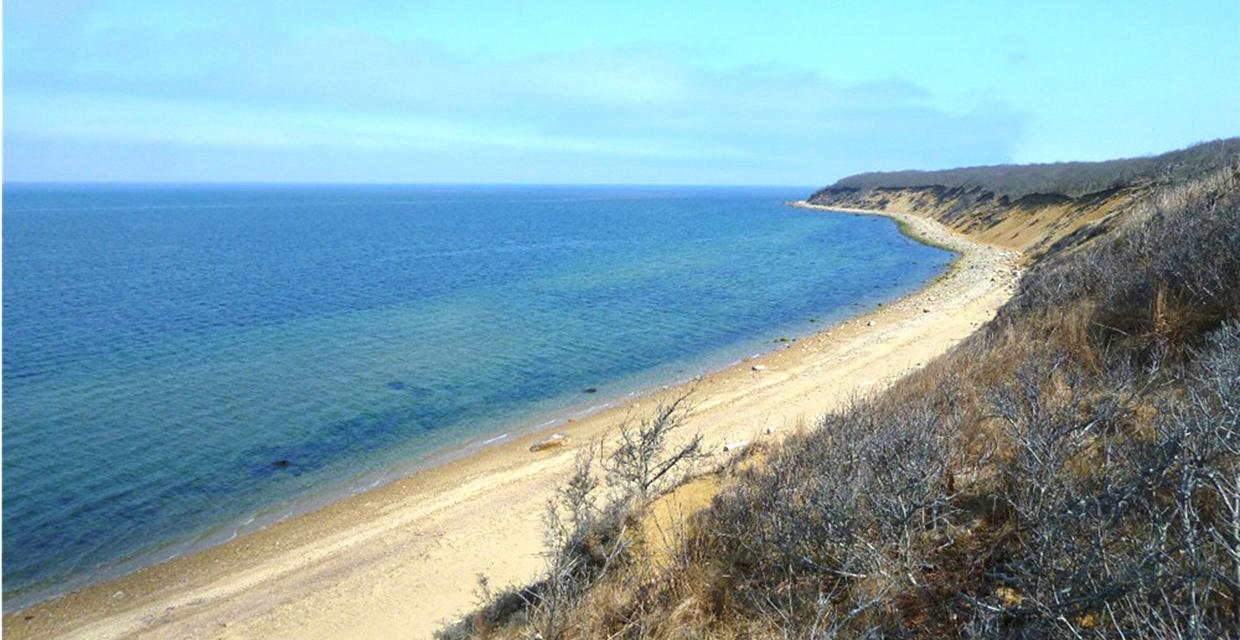
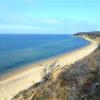
Just shy of the eastern tip of Long Island trails and packed sand roads bring you through different worlds along pitch pines and stunted oaks, through mountain laurel tunnels and hilly woods, to a scenic pond, a canyon and stunning water views from beach level and bluff level.
Hike Checklist:
Whether you are going for a day hike or backpacking overnight, it is good practice to carry what we call The Hiking Essentials. These essentials will help you enjoy your outing more and will provide basic safety gear if needed. There may also be more essentials, depending on the season and your needs.
The Essentials
Hiking Shoes or Boots
Water - Two quarts per person is recommended in every season. Keep in mind that fluid loss is heightened in winter as well as summer. Don't put yourself in the position of having to end your hike early because you have run out of water.
Map - Know where you are and where you are going. Many of our hiking areas feature interconnecting network of trails. Use a waterproof/tear-resistant Tyvek Trail Conference map if available or enclose your map in a Ziplock plastic bag. If you have a mobile device, download Avenza’s free PDF Maps app and grab some GPS-enhanced Trail Conference maps (a backup Tyvek or paper version of the map is good to have just in case your batteries die or you don't have service). Check out some map-reading basics here.
Food - Snacks/lunch will keep you going as you burn energy walking or climbing. Nuts, seeds, and chocolate are favorites on the trail.
Sunscreen and insect repellent
Rain Gear and Extra Clothing - Rain happens. So does cold. Be prepared for changing weather. Avoid cotton--it traps water against your skin and is slow to dry. If you are wearing wet cotton and must return to your starting point, you risk getting chills that may lead to a dangerous hypothermia. Choose synthetic shirts, sweaters and/or vests and dress in layers for easy on and off.
Compass - A simple compass is all you need to orient you and your map to magnetic north.
Light - A flashlight or small, lightweight headlamp will be welcome gear if you find yourself still on the trail when darkness falls. Check the batteries before you start out and have extras in your pack.
First Aid Kit - Keep it simple, compact, and weatherproof. Know how to use the basic components.
Firestarter and Matches - In an emergency, you may need to keep yourself or someone else warm until help arrives. A firestarter (this could be as simple as leftover birthday candles that are kept inside a waterproof container) and matches (again, make sure to keep them in a waterproof container) could save a life.
Knife or Multi-tool - You may need to cut a piece of moleskin to put over a blister, repair a piece of broken equipment, or solve some other unexpected problem.
Emergency Numbers - Know the emergency numbers for the area you're going to and realize that in many locations--especially mountainous ones, your phone will not get reception.
Common Sense - Pay attention to your environment, your energy, and the condition of your companions. Has the weather turned rainy? Is daylight fading? Did you drink all your water? Did your companion fail to bring rain gear? Are you getting tired? Keep in mind that until you turn around you are (typically) only half-way to completing your hike--you must still get back to where you started from! (Exceptions are loop hikes.)
Check the weather forecast before you head out. Know the rules and regulations of the area.
The Leave No Trace Seven Principles
Plan Ahead and Prepare
- Know the regulations and special concerns for the area you'll visit.
- Prepare for extreme weather, hazards, and emergencies.
- Schedule your trip to avoid times of high use.
- Visit in small groups when possible. Consider splitting larger groups into smaller groups.
- Repackage food to minimize waste.
- Use a map and compass to eliminate the use of marking paint, rock cairns or flagging.
Travel and Camp on Durable Surfaces
- Durable surfaces include established trails and campsites, rock, gravel, dry grasses or snow.
- Protect riparian areas by camping at least 200 feet from lakes and streams.
- Good campsites are found, not made. Altering a site is not necessary.
- In popular areas:
- Concentrate use on existing trails and campsites.
- Walk single file in the middle of the trail, even when wet or muddy.
- Keep campsites small. Focus activity in areas where vegetation is absent.
- In pristine areas:
- Disperse use to prevent the creation of campsites and trails.
- Avoid places where impacts are just beginning.
- Pack it in, pack it out. Inspect your campsite and rest areas for trash or spilled foods. Pack out all trash, leftover food and litter.
- Deposit solid human waste in catholes dug 6 to 8 inches deep, at least 200 feet from water, camp and trails. Cover and disguise the cathole when finished.
- Pack out toilet paper and hygiene products.
- To wash yourself or your dishes, carry water 200 feet away from streams or lakes and use small amounts of biodegradable soap. Scatter strained dishwater.
- Preserve the past: examine, but do not touch cultural or historic structures and artifacts.
- Leave rocks, plants and other natural objects as you find them.
- Avoid introducing or transporting non-native species.
- Do not build structures, furniture, or dig trenches.
- Campfires can cause lasting impacts to the backcountry. Use a lightweight stove for cooking and enjoy a candle lantern for light.
- Where fires are permitted, use established fire rings, fire pans, or mound fires.
- Keep fires small. Only use sticks from the ground that can be broken by hand.
- Burn all wood and coals to ash, put out campfires completely, then scatter cool ashes.
- Observe wildlife from a distance. Do not follow or approach them.
- Never feed animals. Feeding wildlife damages their health, alters natural behaviors, and exposes them to predators and other dangers.
- Protect wildlife and your food by storing rations and trash securely.
- Control pets at all times, or leave them at home.
- Avoid wildlife during sensitive times: mating, nesting, raising young, or winter.
Be Considerate of Other Visitors
- Respect other visitors and protect the quality of their experience.
- Be courteous. Yield to other users on the trail.
- Step to the downhill side of the trail when encountering pack stock.
- Take breaks and camp away from trails and other visitors.
- Let nature's sounds prevail. Avoid loud voices and noises.
The Trail Conference is a 2015 Leave No Trace partner.
(c) Leave No Trace Center for Outdoor Ethics: www.LNT.org.


